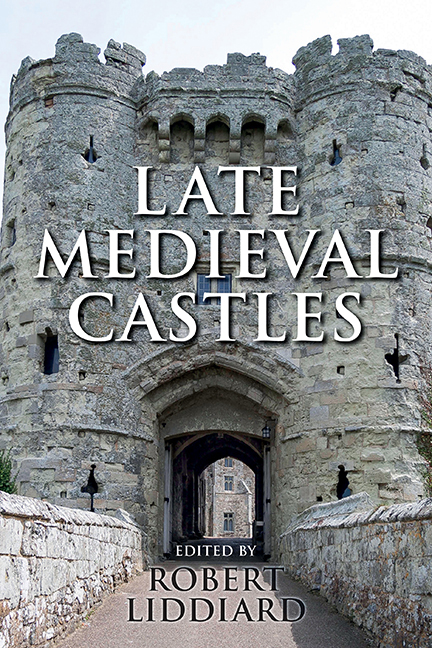Book contents
- Frontmatter
- Contents
- List of Illustrations
- Acknowledgements
- Editor's Preface
- List of Abbreviations
- A Note on the Text
- Introduction
- 1 Fourteenth-Century Castles in Context: Apotheosis or Decline?
- 2 Architects, Advisors and Design at Edward I's Castles in Wales
- 3 The Courtyard and the Tower: Contexts and Symbols in the Development of Late Medieval Great Houses
- 4 Castle Planning in the Fourteenth Century
- 5 Meaningful Constructions: Spatial and Functional Analysis of Medieval Buildings
- 6 Mota, Aula et Turris: The Manor-Houses of the Anglo-Scottish Border
- 7 Lulworth Castle, Dorset
- 8 A Scottish Problem with Castles
- 9 Structural Symbolism in Medieval Castle Architecture
- 10 Specimens of Freedom to Crenellate by Licence
- 11 Some Analysis of the Castle of Bodiam, East Sussex
- 12 English Castles in the Reign Of Edward II
- 13 Castles of Ward and the Changing Pattern of Border Conflict in Ireland
- 14 The Donjon Of Knaresborough: The Castle As Theatre
- 15 The Architecture of Arthurian Enthusiasm: Castle Symbolism in the Reigns of Edward I and his Successors
- 16 Medieval Ornamental Landscapes
- 17 Otherworld Castles in Middle English Arthurian Romance
- Guide to Further Reading
- Index
14 - The Donjon Of Knaresborough: The Castle As Theatre
Published online by Cambridge University Press: 29 April 2017
- Frontmatter
- Contents
- List of Illustrations
- Acknowledgements
- Editor's Preface
- List of Abbreviations
- A Note on the Text
- Introduction
- 1 Fourteenth-Century Castles in Context: Apotheosis or Decline?
- 2 Architects, Advisors and Design at Edward I's Castles in Wales
- 3 The Courtyard and the Tower: Contexts and Symbols in the Development of Late Medieval Great Houses
- 4 Castle Planning in the Fourteenth Century
- 5 Meaningful Constructions: Spatial and Functional Analysis of Medieval Buildings
- 6 Mota, Aula et Turris: The Manor-Houses of the Anglo-Scottish Border
- 7 Lulworth Castle, Dorset
- 8 A Scottish Problem with Castles
- 9 Structural Symbolism in Medieval Castle Architecture
- 10 Specimens of Freedom to Crenellate by Licence
- 11 Some Analysis of the Castle of Bodiam, East Sussex
- 12 English Castles in the Reign Of Edward II
- 13 Castles of Ward and the Changing Pattern of Border Conflict in Ireland
- 14 The Donjon Of Knaresborough: The Castle As Theatre
- 15 The Architecture of Arthurian Enthusiasm: Castle Symbolism in the Reigns of Edward I and his Successors
- 16 Medieval Ornamental Landscapes
- 17 Otherworld Castles in Middle English Arthurian Romance
- Guide to Further Reading
- Index
Summary
The important royal castle of Knaresborough has received surprisingly little attention despite the originality of the arrangements of its donjon. Here it will be argued that the form of the donjon was due to very specific political conditions in the North at the end of the first decade of the fourteenth century, and that the tower's builder conferred on it a deliberate element of theatrical propaganda, which explains otherwise perplexing details in its design.
Knaresborough Castle stands on the edge of a steep cliff above the River Nidd, about three miles from Harrogate and seventeen miles from the city of York (Figure 1). The remains consist of a large courtyard, measuring about 120 metres by 90 metres, once sub-divided by a cross wall, the fragmentary remains of a gateway and small 13-shaped towers, a late medieval domestic building, now heavily rebuilt, and the larger part of a massive five-sided tower of the very early fourteenth century, which was partially demolished as a result of slighting during the Civil War (Figure 2). During most of the Middle Ages the castle was in royal hands, or in the tenure of royal kinsmen, and the majority of the surviving masonry can be ascribed to royal initiatives.
Of the early castle, first recorded in 1129–30, little can now be seen apart from the rock-cut ditches, which were probably the object of King John's expenditure of £1,300 between 1203 and 1214. The small towers, which still survive, and the much-damaged gatehouse on the town side of the castle, are built with solid interiors and gently splayed bases, and thus seem to be of an early design, similar to those at Conisborough Castle, Yorkshire. Unfortunately, too little remains for certainty about their date, but the details of their plinths suggest a date much later in the thirteenth century. They were clearly additions to a comparatively low curtain wall, for their rear faces are grouted against a former smooth surface; nothing else can now be seen above ground that can have belonged to the pre-Edwardian castle. The king's writs and accounts which give details of the early fourteenth-century works at the castle show that the present donjon occupies the site of an older tower, demolished at the end of 1307 or early in 1308.
- Type
- Chapter
- Information
- Late Medieval Castles , pp. 333 - 348Publisher: Boydell & BrewerPrint publication year: 2016



